issue contents
January 2024 issue

editorial
NEUTRON | SYNCHROTRON
Global scientific exchange has been profoundly perturbed by the COVID-19 pandemic, altering user travel behaviours and accelerating the use of remote access. Combined with the advent of artificial intelligence (AI), these trends together can change how large-scale user scientific facilities are used by the community and managed by operators.
scientific commentaries
CHEMISTRY | CRYSTENG
The phenomenon and definition of isostructurality are discussed. It deserves reconsideration regarding the aspects of symmetry, measure of similarity and formation of supramolecular interactions.
ELECTRON CRYSTALLOGRAPHY
This commentary describes a novel method for serial electron diffraction data collection in electron crystallography, utilizing a scanning transmission electron microscope to rapidly obtain patterns with low radiation dose. This approach, demonstrated with zeolite samples, has the potential to provide highly automated and rapid structures from nanocrystalline materials.
feature articles
CHEMISTRY | CRYSTENG
Interoperability of scientific data within crystallography has been achieved to a high level by the adoption of standard exchange formats and protocols. Extending such interoperability across other disciplines is a goal of the International Science Council Committee CODATA, to which the IUCr has been a leading contributor. Our article combines a description of the importance of interoperability for addressing grand challenges with a desire to stimulate the crystallographic community to continue exploring this topic.
research letters
CRYO | EM
An open-source platform for light-coupled cryo-electron microscopy specimen preparation is presented.
research papers
CHEMISTRY | CRYSTENG
Download citation


Download citation


Structural determination and crystallization behavior of paliperidone prodrugs modified with different alkyl chain lengths is described.
MATERIALS | COMPUTATION
A deep-learning method is applied to separate the components of diffuse scattering from chemical short-range order and the molecular form factor. The method is validated against a large simulated dataset and further tested on a real example, resulting in output components of sufficient quality to use for quantitative analysis.
MATERIALS | COMPUTATION
Download citation


Download citation


Hirshfeld atom refinement with anisotropic hydrogen thermal motions estimated using sophisticated methods, such as NoMoRe and SHADE3, was applied to X-ray data collected for transition metal hydride complexes.
CCDC references: 2263007; 2263008; 2263009; 2263059; 2263060; 2263061; 2263062; 2263063; 2263064; 2263065; 2263066; 2263067; 2263068; 2263069; 2263070; 2263071; 2263072; 2263073; 2263074; 2263075; 2263076; 2263322; 2263323; 2263324; 2263325; 2263326; 2263327; 2263328; 2263329; 2263330; 2263331; 2263332; 2263333; 2263334; 2263335; 2263336; 2263337; 2263338; 2263339; 2263340; 2263341; 2263342; 2263343; 2263344; 2263345; 2263346; 2263347; 2263348; 2263349; 2263350; 2263351; 2263352; 2263353; 2263354; 2263355; 2263356; 2263357; 2263358; 2263359; 2263360; 2263361; 2263937; 2263938; 2263939; 2263940; 2263941; 2263942; 2263943; 2263944; 2263945; 2263946; 2263947; 2263949; 2263950; 2306347; 2306348
CHEMISTRY | CRYSTENG
Download citation


Download citation


The most stable trans–trans conformation of the diethyl ether molecule hinders its aggregation due to restricted access to the oxygen atom. This hindrance can be removed by conformational transformation under high pressure.
ELECTRON CRYSTALLOGRAPHY
Download citation


Download citation


An implementation of scanning transmission electron microscopy serial electron diffraction (SerialED) through scripting is proposed. SerialED and continuous-rotation electron diffraction refinement results for the structure of zeolite Y are compared, and the structure of beam-sensitive ZSM-25 is solved by direct methods from electron diffraction data for the first time.
NEUTRON | SYNCHROTRON
A deep-learning based speckle-tracking imaging method is developed, and high-accuracy phase retrieval is successfully achieved with a single shot.
ELECTRON CRYSTALLOGRAPHY
This study compares, for the first time, short-range order parameters refined from the diffuse scattering in single-crystal X-ray and single-crystal electron diffraction data.
PHYSICS | FELS
A method is described for determining the 3D structure of a sample from X-ray free-electron laser single-particle diffraction patterns by analyzing different orders of spatial correlations of diffraction intensities.
NEUTRON | SYNCHROTRON
The alignment and self-assembly behavior of silica–nickel Janus particles in an external magnetic field were probed by ultra small-angle X-ray scattering. A theoretical framework is provided for the quantitative interpretation of the observed anisotropic scattering features.
NEUTRON | SYNCHROTRON
Grazing-incidence total X-ray scattering allows for orientational pair distribution function analysis of indium oxide thin films with only a single measurement. Elucidation of information such as effects of film anisotropy on bond lengths in specific orientations relative to the substrate and determination of orientation in X-ray amorphous films is demonstrated.


 journal menu
journal menu




 access
access




























